- Unity User Manual (2017.4)
- 图形
- 图形参考
- 着色器参考
- 编写表面着色器
- 表面着色器示例
表面着色器示例
以下是表面着色器的几个示例。以下示例重点说明如何使用内置光照模型;有关如何实现自定义光照模型的示例,请参阅表面着色器光照示例。
简单着色器
我们将从一个非常简单的着色器 (Shader) 开始,并在此基础上加以丰富。下面的着色器将表面颜色设置为“白色”。它使用内置的兰伯特(漫射)光照模型。
Shader "Example/Diffuse Simple" {
SubShader {
Tags { "RenderType" = "Opaque" }
CGPROGRAM
#pragma surface surf Lambert
struct Input {
float4 color : COLOR;
};
void surf (Input IN, inout SurfaceOutput o) {
o.Albedo = 1;
}
ENDCG
}
Fallback "Diffuse"
}
以下是设置了两个光源的模型:

纹理
一个全白的对象很无聊,所以让我们添加一个纹理。我们将向着色器添加 Properties 代码块,这样我们将在材质中看到纹理选择器。其他更改在下文中以粗体显示。
Shader "Example/Diffuse Texture" {
Properties {
_MainTex ("Texture", 2D) = "white" {}
}
SubShader {
Tags { "RenderType" = "Opaque" }
CGPROGRAM
#pragma surface surf Lambert
struct Input {
float2 uv_MainTex;
};
sampler2D _MainTex;
void surf (Input IN, inout SurfaceOutput o) {
o.Albedo = tex2D (_MainTex, IN.uv_MainTex).rgb;
}
ENDCG
}
Fallback "Diffuse"
}
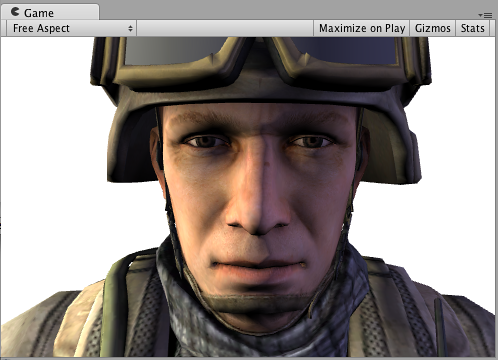
法线贴图
我们来添加一些法线贴图:
Shader "Example/Diffuse Bump" {
Properties {
_MainTex ("Texture", 2D) = "white" {}
_BumpMap ("Bumpmap", 2D) = "bump" {}
}
SubShader {
Tags { "RenderType" = "Opaque" }
CGPROGRAM
#pragma surface surf Lambert
struct Input {
float2 uv_MainTex;
float2 uv_BumpMap;
};
sampler2D _MainTex;
sampler2D _BumpMap;
void surf (Input IN, inout SurfaceOutput o) {
o.Albedo = tex2D (_MainTex, IN.uv_MainTex).rgb;
o.Normal = UnpackNormal (tex2D (_BumpMap, IN.uv_BumpMap));
}
ENDCG
}
Fallback "Diffuse"
}
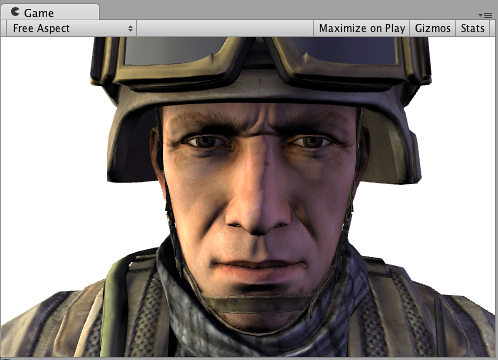
边缘光照
现在,尝试添加一些边缘光照以突出游戏对象的边缘。我们将根据表面法线和视图方向之间的角度添加一些发射光照。为此,我们将使用内置的表面着色器变量 viewDir。
Shader "Example/Rim" {
Properties {
_MainTex ("Texture", 2D) = "white" {}
_BumpMap ("Bumpmap", 2D) = "bump" {}
_RimColor ("Rim Color", Color) = (0.26,0.19,0.16,0.0)
_RimPower ("Rim Power", Range(0.5,8.0)) = 3.0
}
SubShader {
Tags { "RenderType" = "Opaque" }
CGPROGRAM
#pragma surface surf Lambert
struct Input {
float2 uv_MainTex;
float2 uv_BumpMap;
float3 viewDir;
};
sampler2D _MainTex;
sampler2D _BumpMap;
float4 _RimColor;
float _RimPower;
void surf (Input IN, inout SurfaceOutput o) {
o.Albedo = tex2D (_MainTex, IN.uv_MainTex).rgb;
o.Normal = UnpackNormal (tex2D (_BumpMap, IN.uv_BumpMap));
half rim = 1.0 - saturate(dot (normalize(IN.viewDir), o.Normal));
o.Emission = _RimColor.rgb * pow (rim, _RimPower);
}
ENDCG
}
Fallback "Diffuse"
}

细节纹理
为获得不同效果,让我们添加一个与基础纹理结合的细节纹理。细节纹理通常在材质中使用相同的 UV,但使用不同平铺,因此我们需要使用不同的输入 UV 坐标。
Shader "Example/Detail" {
Properties {
_MainTex ("Texture", 2D) = "white" {}
_BumpMap ("Bumpmap", 2D) = "bump" {}
_Detail ("Detail", 2D) = "gray" {}
}
SubShader {
Tags { "RenderType" = "Opaque" }
CGPROGRAM
#pragma surface surf Lambert
struct Input {
float2 uv_MainTex;
float2 uv_BumpMap;
float2 uv_Detail;
};
sampler2D _MainTex;
sampler2D _BumpMap;
sampler2D _Detail;
void surf (Input IN, inout SurfaceOutput o) {
o.Albedo = tex2D (_MainTex, IN.uv_MainTex).rgb;
o.Albedo *= tex2D (_Detail, IN.uv_Detail).rgb * 2;
o.Normal = UnpackNormal (tex2D (_BumpMap, IN.uv_BumpMap));
}
ENDCG
}
Fallback "Diffuse"
}
使用纹理棋盘格不一定有实际意义,但在此示例中可用于说明其作用:
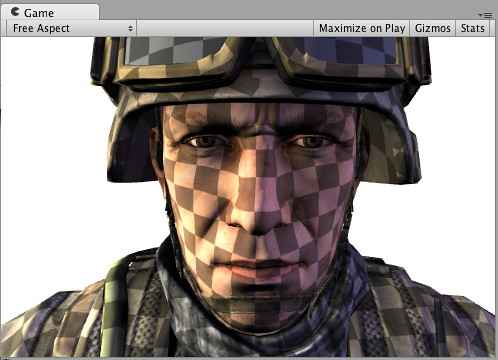
屏幕空间中的细节纹理
屏幕空间中的细节纹理对于士兵头部模型没有实际意义,但是在这里可用于说明如何使用内置的 screenPos 输入:
Shader "Example/ScreenPos" {
Properties {
_MainTex ("Texture", 2D) = "white" {}
_Detail ("Detail", 2D) = "gray" {}
}
SubShader {
Tags { "RenderType" = "Opaque" }
CGPROGRAM
#pragma surface surf Lambert
struct Input {
float2 uv_MainTex;
float4 screenPos;
};
sampler2D _MainTex;
sampler2D _Detail;
void surf (Input IN, inout SurfaceOutput o) {
o.Albedo = tex2D (_MainTex, IN.uv_MainTex).rgb;
float2 screenUV = IN.screenPos.xy / IN.screenPos.w;
screenUV *= float2(8,6);
o.Albedo *= tex2D (_Detail, screenUV).rgb * 2;
}
ENDCG
}
Fallback "Diffuse"
}
从上面的着色器删除了法线贴图,只是为了缩短代码长度:
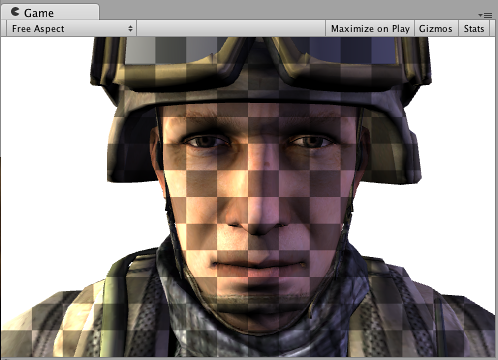
立方体贴图反射
下面的着色器将使用内置 worldRefl 输入来进行立方体贴图反射。它与内置的反射/漫射着色器非常类似:
Shader "Example/WorldRefl" {
Properties {
_MainTex ("Texture", 2D) = "white" {}
_Cube ("Cubemap", CUBE) = "" {}
}
SubShader {
Tags { "RenderType" = "Opaque" }
CGPROGRAM
#pragma surface surf Lambert
struct Input {
float2 uv_MainTex;
float3 worldRefl;
};
sampler2D _MainTex;
samplerCUBE _Cube;
void surf (Input IN, inout SurfaceOutput o) {
o.Albedo = tex2D (_MainTex, IN.uv_MainTex).rgb * 0.5;
o.Emission = texCUBE (_Cube, IN.worldRefl).rgb;
}
ENDCG
}
Fallback "Diffuse"
}
因为它将反射颜色指定为 __Emission__,所以我们得到了一个非常闪亮的士兵:

如果您想做一些受法线贴图影响的反射,需要稍微复杂一些:需要将 INTERNAL_DATA 添加到 Input 结构,并使用 WorldReflectionVector 函数在写入法线输出后计算每像素反射矢量。
Shader "Example/WorldRefl Normalmap" {
Properties {
_MainTex ("Texture", 2D) = "white" {}
_BumpMap ("Bumpmap", 2D) = "bump" {}
_Cube ("Cubemap", CUBE) = "" {}
}
SubShader {
Tags { "RenderType" = "Opaque" }
CGPROGRAM
#pragma surface surf Lambert
struct Input {
float2 uv_MainTex;
float2 uv_BumpMap;
float3 worldRefl;
INTERNAL_DATA
};
sampler2D _MainTex;
sampler2D _BumpMap;
samplerCUBE _Cube;
void surf (Input IN, inout SurfaceOutput o) {
o.Albedo = tex2D (_MainTex, IN.uv_MainTex).rgb * 0.5;
o.Normal = UnpackNormal (tex2D (_BumpMap, IN.uv_BumpMap));
o.Emission = texCUBE (_Cube, WorldReflectionVector (IN, o.Normal)).rgb;
}
ENDCG
}
Fallback "Diffuse"
}
下面是一个进行了法线贴图的闪亮士兵:
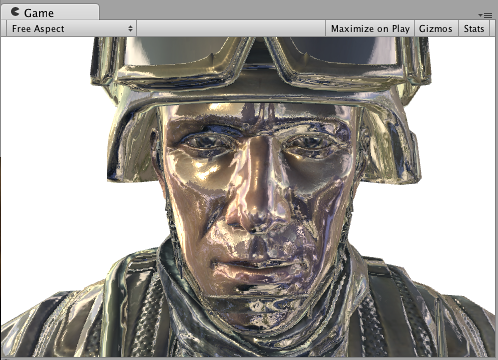
通过世界空间位置进行的切片
下面的着色器通过丢弃几乎水平的环形中的像素来对游戏对象“切片”。为实现此效果,它使用了基于像素世界位置的 Cg/HLSL 函数 clip()。我们将使用内置的表面着色器变量 worldPos。
Shader "Example/Slices" {
Properties {
_MainTex ("Texture", 2D) = "white" {}
_BumpMap ("Bumpmap", 2D) = "bump" {}
}
SubShader {
Tags { "RenderType" = "Opaque" }
Cull Off
CGPROGRAM
#pragma surface surf Lambert
struct Input {
float2 uv_MainTex;
float2 uv_BumpMap;
float3 worldPos;
};
sampler2D _MainTex;
sampler2D _BumpMap;
void surf (Input IN, inout SurfaceOutput o) {
clip (frac((IN.worldPos.y+IN.worldPos.z*0.1) * 5) - 0.5);
o.Albedo = tex2D (_MainTex, IN.uv_MainTex).rgb;
o.Normal = UnpackNormal (tex2D (_BumpMap, IN.uv_BumpMap));
}
ENDCG
}
Fallback "Diffuse"
}
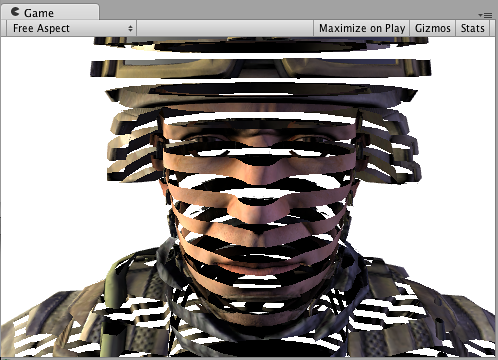
使用顶点修改器进行法线挤出
可以使用“顶点修改器”函数来修改顶点着色器中的传入顶点数据。这可用于程序化动画和沿法线挤出等操作。表面着色器编译指令 vertex:functionName 将用于此目的,其中的一个函数采用 inout appdata_full 参数。
以下着色器沿着法线按照材质中指定的量移动顶点:
Shader "Example/Normal Extrusion" {
Properties {
_MainTex ("Texture", 2D) = "white" {}
_Amount ("Extrusion Amount", Range(-1,1)) = 0.5
}
SubShader {
Tags { "RenderType" = "Opaque" }
CGPROGRAM
#pragma surface surf Lambert vertex:vert
struct Input {
float2 uv_MainTex;
};
float _Amount;
void vert (inout appdata_full v) {
v.vertex.xyz += v.normal * _Amount;
}
sampler2D _MainTex;
void surf (Input IN, inout SurfaceOutput o) {
o.Albedo = tex2D (_MainTex, IN.uv_MainTex).rgb;
}
ENDCG
}
Fallback "Diffuse"
}
沿着法线移动顶点会产生一个肥胖的士兵:
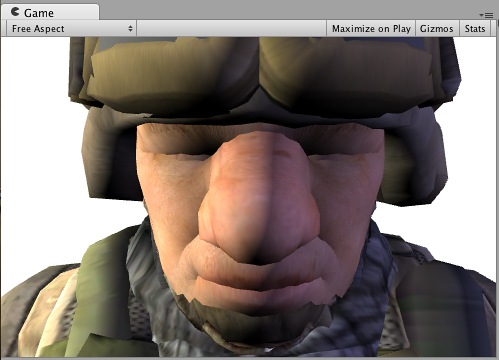
每顶点计算的自定义数据
使用顶点修改器函数,还可以在顶点着色器中计算自定义数据,然后将数据按像素传递给表面着色器函数。此情况下使用相同的编译指令 vertex:functionName,但该函数应采用两个参数:inout appdata_full 和 out Input。您可以在其中填写除内置值以外的任何输入成员。
注意:以这种方式使用的自定义输入成员不得包含以“uv”开头的名称,否则它们将无法正常工作。
下面的示例定义了一个在顶点函数中计算的自定义 float3 customColor 成员:
Shader "Example/Custom Vertex Data" {
Properties {
_MainTex ("Texture", 2D) = "white" {}
}
SubShader {
Tags { "RenderType" = "Opaque" }
CGPROGRAM
#pragma surface surf Lambert vertex:vert
struct Input {
float2 uv_MainTex;
float3 customColor;
};
void vert (inout appdata_full v, out Input o) {
UNITY_INITIALIZE_OUTPUT(Input,o);
o.customColor = abs(v.normal);
}
sampler2D _MainTex;
void surf (Input IN, inout SurfaceOutput o) {
o.Albedo = tex2D (_MainTex, IN.uv_MainTex).rgb;
o.Albedo *= IN.customColor;
}
ENDCG
}
Fallback "Diffuse"
}
在此示例中,customColor 设置为法线的绝对值:
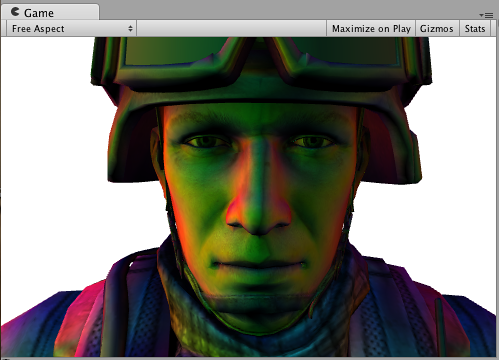
更实际的用途可能是计算内置输入变量不提供的任何每顶点数据;或优化着色器计算。例如,可以在游戏对象的顶点处计算边缘光照,而不是在表面着色器中按照每个像素进行计算。
最终颜色修改器
可以使用“最终颜色修改器”函数来修改着色器计算的最终颜色。表面着色器编译指令 finalcolor:functionName 将用于此目的,其中的一个函数采用 Input IN, SurfaceOutput o, inout fixed4 color 参数。
下面是一个简单的着色器,它将色调应用于最终颜色。这与仅对表面反照率颜色应用色调不同:此色调还会影响来自光照贴图、光照探针和类似额外来源的任何颜色。
Shader "Example/Tint Final Color" {
Properties {
_MainTex ("Texture", 2D) = "white" {}
_ColorTint ("Tint", Color) = (1.0, 0.6, 0.6, 1.0)
}
SubShader {
Tags { "RenderType" = "Opaque" }
CGPROGRAM
#pragma surface surf Lambert finalcolor:mycolor
struct Input {
float2 uv_MainTex;
};
fixed4 _ColorTint;
void mycolor (Input IN, SurfaceOutput o, inout fixed4 color)
{
color *= _ColorTint;
}
sampler2D _MainTex;
void surf (Input IN, inout SurfaceOutput o) {
o.Albedo = tex2D (_MainTex, IN.uv_MainTex).rgb;
}
ENDCG
}
Fallback "Diffuse"
}

使用最终颜色修改器自定义雾效
使用最终颜色修改器(见上文)的常见情况是在前向渲染中实现完全自定义的雾效。雾效需要影响最终计算的像素着色器颜色,这正是 finalcolor 修改器的功能。
下面是一个根据与屏幕中心的距离应用雾效色调的着色器。此着色器将顶点修改器与自定义顶点数据 (fog) 和最终颜色修改器组合在一起。用于前向渲染附加通道时,雾效需要淡化为黑色。此示例将解决这一问题并检查是否有 UNITY_PASS_FORWARDADD。
Shader "Example/Fog via Final Color" {
Properties {
_MainTex ("Texture", 2D) = "white" {}
_FogColor ("Fog Color", Color) = (0.3, 0.4, 0.7, 1.0)
}
SubShader {
Tags { "RenderType" = "Opaque" }
CGPROGRAM
#pragma surface surf Lambert finalcolor:mycolor vertex:myvert
struct Input {
float2 uv_MainTex;
half fog;
};
void myvert (inout appdata_full v, out Input data)
{
UNITY_INITIALIZE_OUTPUT(Input,data);
float4 hpos = UnityObjectToClipPos(v.vertex);
hpos.xy/=hpos.w;
data.fog = min (1, dot (hpos.xy, hpos.xy)*0.5);
}
fixed4 _FogColor;
void mycolor (Input IN, SurfaceOutput o, inout fixed4 color)
{
fixed3 fogColor = _FogColor.rgb;
#ifdef UNITY_PASS_FORWARDADD
fogColor = 0;
#endif
color.rgb = lerp (color.rgb, fogColor, IN.fog);
}
sampler2D _MainTex;
void surf (Input IN, inout SurfaceOutput o) {
o.Albedo = tex2D (_MainTex, IN.uv_MainTex).rgb;
}
ENDCG
}
Fallback "Diffuse"
}

线性雾效
Shader "Example/Linear Fog" {
Properties {
_MainTex ("Base (RGB)", 2D) = "white" {}
}
SubShader {
Tags { "RenderType"="Opaque" }
LOD 200
CGPROGRAM
#pragma surface surf Lambert finalcolor:mycolor vertex:myvert
#pragma multi_compile_fog
sampler2D _MainTex;
uniform half4 unity_FogStart;
uniform half4 unity_FogEnd;
struct Input {
float2 uv_MainTex;
half fog;
};
void myvert (inout appdata_full v, out Input data) {
UNITY_INITIALIZE_OUTPUT(Input,data);
float pos = length(UnityObjectToViewPos(v.vertex).xyz);
float diff = unity_FogEnd.x - unity_FogStart.x;
float invDiff = 1.0f / diff;
data.fog = clamp ((unity_FogEnd.x - pos) * invDiff, 0.0, 1.0);
}
void mycolor (Input IN, SurfaceOutput o, inout fixed4 color) {
#ifdef UNITY_PASS_FORWARDADD
UNITY_APPLY_FOG_COLOR(IN.fog, color, float4(0,0,0,0));
#else
UNITY_APPLY_FOG_COLOR(IN.fog, color, unity_FogColor);
#endif
}
void surf (Input IN, inout SurfaceOutput o) {
half4 c = tex2D (_MainTex, IN.uv_MainTex);
o.Albedo = c.rgb;
o.Alpha = c.a;
}
ENDCG
}
FallBack "Diffuse"
}
贴花
贴花通常用于在运行时向材质添加细节(例如,子弹冲击力效果)。贴花在延迟渲染中特别有用,因为贴花在照亮之前会改变 G 缓冲区,因此可以节省开销。
在常规情况下,贴花应该在不透明对象之后渲染,并且不应该是阴影投射物,如以下示例中的 ShaderLab“Tags”中所示。
Shader "Example/Decal" {
Properties {
_MainTex ("Base (RGB)", 2D) = "white" {}
}
SubShader {
Tags { "RenderType"="Opaque" "Queue"="Geometry+1" "ForceNoShadowCasting"="True" }
LOD 200
Offset -1, -1
CGPROGRAM
#pragma surface surf Lambert decal:blend
sampler2D _MainTex;
struct Input {
float2 uv_MainTex;
};
void surf (Input IN, inout SurfaceOutput o) {
half4 c = tex2D (_MainTex, IN.uv_MainTex);
o.Albedo = c.rgb;
o.Alpha = c.a;
}
ENDCG
}
}